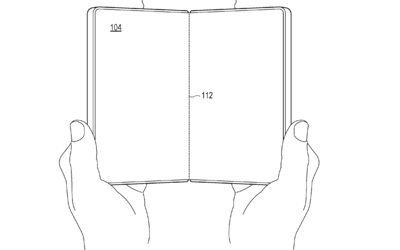Microsoft plans to take on iPhone and Android smartphones with this new device
Microsoft is not giving up on its ambitions in the mobile device market. Despite the discontinuation of the Surface Duo line, the tech giant has filed a patent for a new foldable device that aims to compete with offerings from Apple and Android manufacturers.

The patent application, filed with the United States Patent and Trademark Office on February 29, details a foldable smartphone concept featuring a unique single-hinge system dubbed the "spine cover plate." This design aims to address key challenges in the foldable market, including hinge durability and the visibility of the crease on the display.
Galaxy Z Fold Inspiration?
The application suggests a book-style design similar to the Samsung Galaxy Z Fold, featuring a flexible display. The primary focus, however, is on the spine cover plate mechanism. This mechanism is designed to protect the single hinge system by covering the structural element, offering enhanced durability.
The key innovation lies in the spine cover's ability to adjust automatically during opening and closing. This prevents unnecessary gaps around the hinge, offering protection against dust and water ingress. While Samsung's current foldable design boasts an IPX8 rating (water resistance), Microsoft's approach could potentially offer a higher level of protection.
Tackling the Crease
The patent also suggests that the new hinge mechanism could significantly reduce the visibility of the crease, a common issue with current foldable devices. Furthermore, Microsoft is exploring techniques to minimize the overall thickness of the foldable smartphone. The spine cover plate can retract towards the central spine when the device is folded, leading to a slimmer profile and improved handling.
Microsoft's patent states, "By retracting the spine cover plate toward the central spine as the first display-supporting frame and the second display-supporting frame are rotated into a face-to-face orientation, the width of the folded computing device is reduced, thereby enabling easier and more comfortable handling of the device, such as with one hand."
Practicality in Question
The pursuit of a crease-free foldable phone is a major focus in the smartphone industry. While some manufacturers have implemented water-drop folding mechanisms to mitigate the crease, a truly seamless foldable display remains elusive. Durability is also paramount, given the multiple moving parts in foldable devices.
The addition of another movable part on top of the existing foldable mechanism raises questions about practicality and long-term reliability. Despite the potential benefits and enhanced durability outlined in the patent, the complexity of the design may present challenges.
Newer articles
-
 Nasa spacecraft around the moon photographs the crash site of a Japanese company's lunar lander
Nasa spacecraft around the moon photographs the crash site of a Japanese company's lunar lander
-
 3 ways Google aims to support the 2024 Indian General Elections
3 ways Google aims to support the 2024 Indian General Elections
-
 Pins and needles all over the body? Here's what it means
Pins and needles all over the body? Here's what it means
-
 Chipmaker TSMC returns to the list of world's 10 most valuable companies: Here’s what led to its comeback
Chipmaker TSMC returns to the list of world's 10 most valuable companies: Here’s what led to its comeback
-
 IND vs ENG, 1st Test Day 2 Highlights: Pant’s flair, Bumrah’s fire, but Pope stands tall to keep England afloat
IND vs ENG, 1st Test Day 2 Highlights: Pant’s flair, Bumrah’s fire, but Pope stands tall to keep England afloat
-
 What if we stopped having babies? Humanity could vanish within 100 years, new study warns
What if we stopped having babies? Humanity could vanish within 100 years, new study warns
-
 Priyanka Chopra enjoys dinner at Vikas Khanna’s Bungalow in NYC; chef dedicates ceiling decor to Malti Marie
Priyanka Chopra enjoys dinner at Vikas Khanna’s Bungalow in NYC; chef dedicates ceiling decor to Malti Marie
-
 This new AI tool can help you book train tickets, get refunds and check details on IRCTC website and app
This new AI tool can help you book train tickets, get refunds and check details on IRCTC website and app
-
 NASA astronauts prepare ‘space sushi’ aboard the ISS in zero gravity during a heartwarming crew celebration
NASA astronauts prepare ‘space sushi’ aboard the ISS in zero gravity during a heartwarming crew celebration
-
 The summer solstice is here. What to know about the longest day of the year
The summer solstice is here. What to know about the longest day of the year